Diffuse and Direct UV Index Experimental Values
Abstract
:1. Introduction
2. Materials and Methods
3. Results
3.1. Diffuse and Direct UVER and UV Index
3.2. Diffuse and Direct Erythemal Doses
4. Discussion
Author Contributions
Funding
Institutional Review Board Statement
Informed Consent Statement
Data Availability Statement
Conflicts of Interest
References
- ISO 17166:1999/CIE S007-1998; Erythema Reference Action Spectrum and Standard Erythema Dose. CIE: Vienna, Austria, 1998. Available online: https://doi.org/10.1002/(SICI)1520-6378(199904)24:2<158::AID-COL11>3.0.CO;2-4 (accessed on 28 June 2023).
- Vanicek, K.; Frei, T.; Litynska, Z.; Schmalwieser, A. UV-Index for the Public. COST-713 Action (UV-B Forecasting); Office for Official Publications of the European Communities: Luxembourg, 2000; p. 27. Available online: https://op.europa.eu/en/publication-detail/-/publication/ed2d6032-860f-4237-bb16-c34a7daceb17 (accessed on 1 June 2023).
- World Health Organization (WHO); World Meteorological Organization (WMO); United Nations Environment Programme (UNEP); International Commission on Non-Ionizing Radiation Protection (ICNIRP). Global Solar UV Index: A Practical Guide; Watch No. 95, WMO/TD No. 625; World Health Organization: Geneva, Switzerland, 2002; p. 28. Available online: https://apps.who.int/iris/handle/10665/42459 (accessed on 1 June 2023).
- WMO. Report of the WMO–WHO Meeting of Experts on Standardization of UV Indices and Their Dissemination to the Public, WMO/TD-No. 921; Global Atmosphere Watch No. 127; WMO: Les Diablerets, Switzerland, 1998. Available online: https://library.wmo.int/index.php?lvl=notice_display&id=11059 (accessed on 1 June 2023).
- Utrillas, M.P.; Marín, M.J.; Esteve, A.R.; Tena, F.; Cañada, J.; Estellés, V.; Martínez-Lozano, J.A. Diffuse UV erythemal radiation experimental values. J. Geophys. Res. 2007, 112, D24207. [Google Scholar] [CrossRef] [Green Version]
- Esteve, A.R.; Marín, M.J.; Tena, F.; Utrillas, M.P.; Martínez-Lozano, J.A. The influence of cloudiness over the values of erythemal radiation in Valencia, Spain. Int. J. Climatol. 2009, 29, 2171–2182. [Google Scholar] [CrossRef]
- Utrillas, M.P.; Marín, M.J.; Esteve, A.R.; Estellés, V.; Tena, F.; Cañada, J.; Martínez-Lozano, J.A. Diffuse Ultraviolet Erythemal Irradiance on Inclined Planes: A Comparison of Experimental and Modeled Data. Photochem. Photobiol. 2009, 85, 1245–1253. [Google Scholar] [CrossRef]
- Parisi, A.V.; Sabburg, J.; Kimlin, M.G. Diffuse Ambient Solar UV. In Scattered and Filtered Solar UV Measurements. Advances in Global Change Research; Springer: Dordrecht, The Netherlands, 2004; Volume 17, pp. 27–51. [Google Scholar] [CrossRef]
- Parisi, A.V.; Green, A.; Kimlin, M.G. Diffuse Solar UV Radiation and Implications for Preventing Human Eye Damage. Photochem. Photobiol. 2001, 73, 135–139. [Google Scholar] [CrossRef]
- Silva, A.A. The diffuse component of erythemal ultraviolet radiation. Photochem. Photobiol. Sci. 2015, 14, 1941–1951. [Google Scholar] [CrossRef] [PubMed]
- Scaglione, D.; Giulietti, D.; Morelli, M. Evaluation of the impact of atmospheric ozone and aerosols on the horizontal global/diffuse UV Index at Livorno (Italy). J. Atmos. Sol. Terr. Phys. 2016, 146, 194–204. [Google Scholar] [CrossRef]
- Martínez-Lozano, J.A.; Utrillas, M.P.; Tena, F.; Pedros, R.; Cañada, J.; Boscá, J.V.; Lorente, J. Aerosol optical characteristics from a summer campaign in an urban coastal Mediterranean area. IEEE Trans. Geosci. Remote Sens. 2001, 39, 1573–1585. [Google Scholar] [CrossRef]
- Utrillas, M.P.; Cañada, J.; Tamayo, J.; Martínez-Lozano, J.A. Column-integrated aerosol optical properties in the free troposphere. Case study: Sierra Nevada, Spain. IEEE Trans. Geosci. Remote Sens. 2004, 42, 2268–2276. [Google Scholar] [CrossRef]
- Cannon, T.W. Spectral solar irradiance instrumentation and measurement techniques. Sol. Cells 1986, 18, 231–241. [Google Scholar] [CrossRef]
- Utrillas, M.P.; Pedrós, R.; Gandía, S.; Gómez-Amo, J.L.; Estellés, V.; Martínez-Lozano, J.A. Measurements of integrated direct, diffuse and global ultraviolet-B radiation. Energy 2015, 93, 1658–1662. [Google Scholar] [CrossRef]
- Vilaplana, J.M.; Cachorro, V.E.; Sorribas, M.; Luccini, E.; de Frutos, A.M.; Berjon, A.; de la Morena, B. Modified calibration procedures for a Yankee environmental system UVB-1 biometer based on spectral measurements with a Brewer spectrophotometer. Photochem. Photobiol. 2006, 82, 508–514. [Google Scholar] [CrossRef] [PubMed]
- Esteve, A.R.; Martínez-Lozano, J.A.; Marín, M.J.; Estellés, V.; Tena, F.; Utrillas, M.P. Influence of the ozone and the aerosols over experimental values of UV erythemal radiation a ground level, at Valencia. Int. J. Climatol. 2009, 29, 2171–2182. [Google Scholar] [CrossRef]
- Martínez-Lozano, J.A.; Utrillas, M.P.; Núnez, J.A.; Esteve, A.R.; Gómez-Amo, J.L.; Estellés, V.; Pedrós, R. Measurement and analysis of broadband UVB solar radiation in Spain. Photochem. Photobiol. 2012, 88, 1489–1496. [Google Scholar] [CrossRef] [PubMed] [Green Version]
- Utrillas, M.P.; Marín, M.J.; Esteve, A.R.; Estellés, V.; Gandía, S.; Núnez, J.A.; Martínez-Lozano, J.A. Ten years of measured UV Index from the Spanish UVB Radiometric Network. J. Photochem. Photobiol. B 2013, 125, 1–7. [Google Scholar] [CrossRef] [PubMed]
- Marín, M.J. Estudio de la Irradiancia Solar Ultravioleta B y Eritemática en la Comunidad Valenciana. Ph.D. Thesis, Universitat de València, València, Spain, 16 February 2007. (In Spanish). Available online: https://www.educacion.gob.es/teseo/mostrarRef.do?ref=410925 (accessed on 28 June 2023).
- Marchetti, F.; Esteve, A.R.; Siani, A.M.; Martínez-Lozano, J.A.; Utrillas, M.P. Validación de los datos de radiación solar UV del Ozone Monitoring Instrument (OMI) a partir de medidas con base en tierra en la costa mediterránea. Rev. Teledetec. 2016, 47, 13–22. (In Spanish) [Google Scholar] [CrossRef] [Green Version]
- Sánchez-Pérez, J.F.; Vicente-Agullo, D.; Barberá, M.; Castro-Rodríguez, E.; Cánovas, M. Relationship between ultraviolet index (UVI) and first-, second-and third-degree sunburn using the Probit methodology. Sci. Rep. 2019, 9, 733. [Google Scholar] [CrossRef] [PubMed] [Green Version]
- Malinović-Milićević, S.; Mihailović, A.; Mihailović, D.T. Kolmogorov Complexity Analysis and Prediction Horizon of the Daily Erythemal Dose Time Series. Atmosphere 2022, 13, 746. [Google Scholar] [CrossRef]
- Marín, M.J.; Sola, Y.; Tena, F.; Utrillas, M.P.; Campmany, E.; de Cabo, X.; Lorente, J.; Martínez-Lozano, J.A. The UV index on the Spanish Mediterranean coast. Photochem. Photobiol. 2005, 81, 659–665. [Google Scholar] [CrossRef] [PubMed]
- Utrillas, M.P.; Martínez-Lozano, J.A.; Núñez, M. Ultraviolet Radiation Protection by a Beach Umbrella. Photochem. Photobiol. 2010, 86, 449–456. [Google Scholar] [CrossRef]
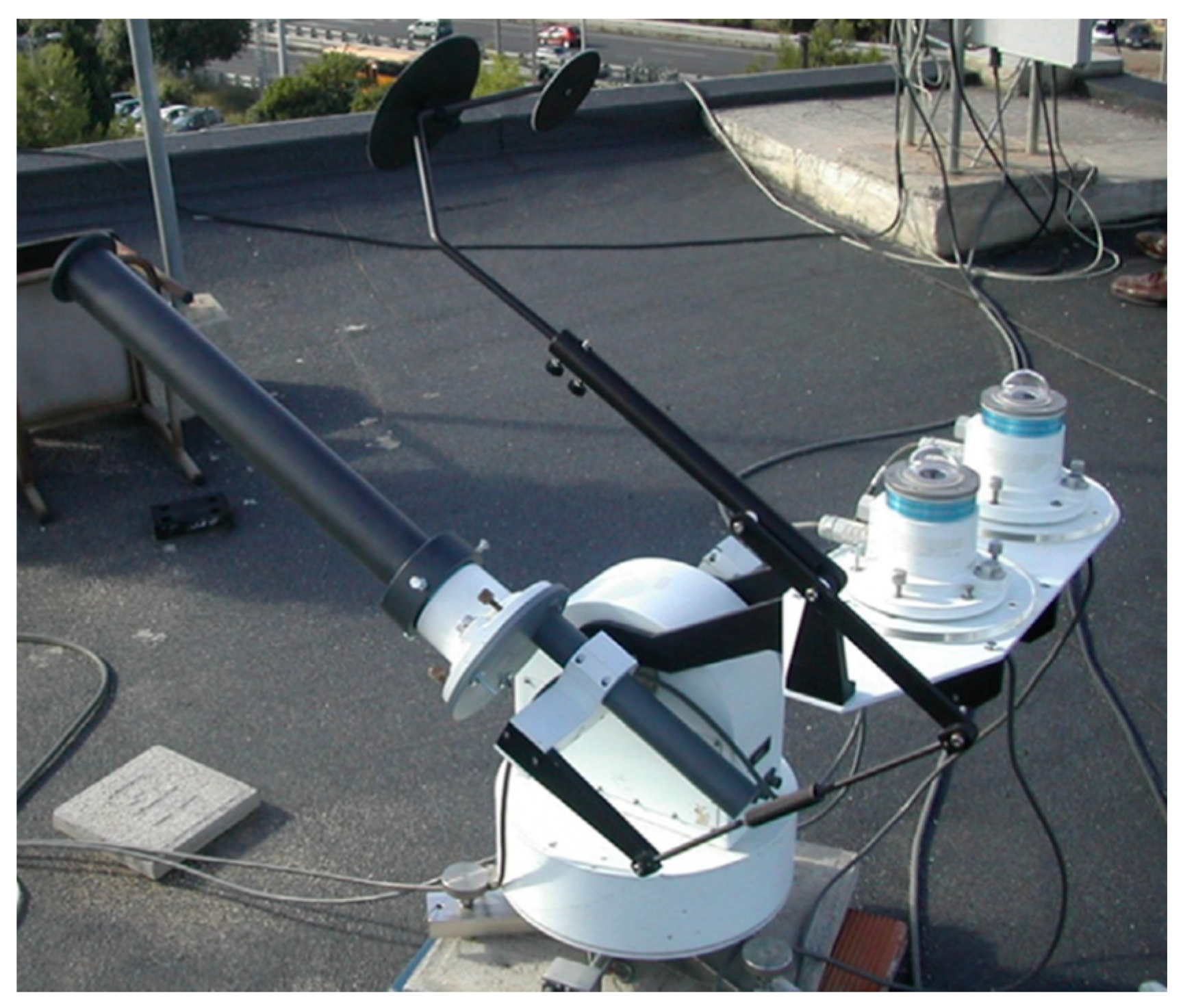

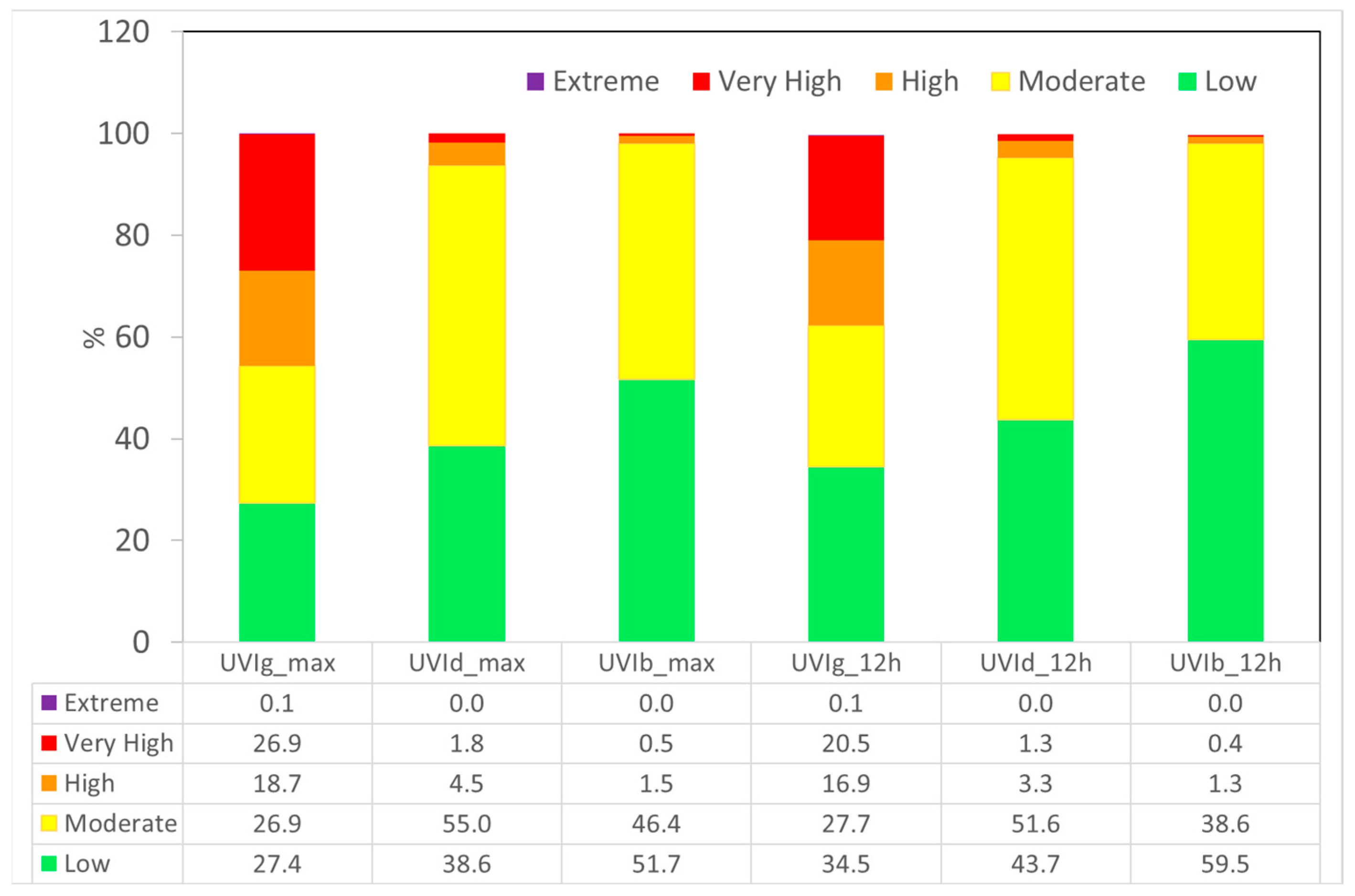
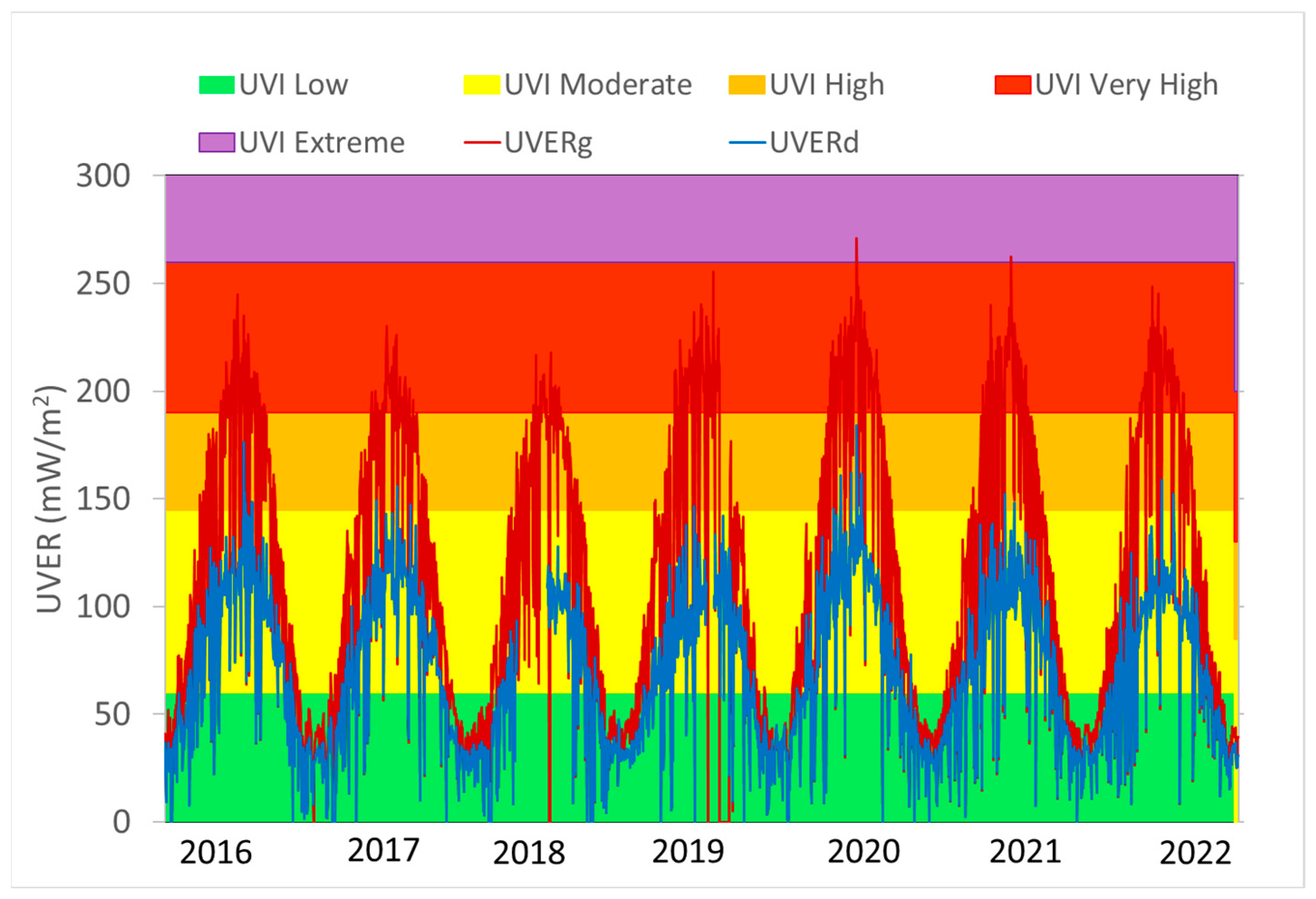
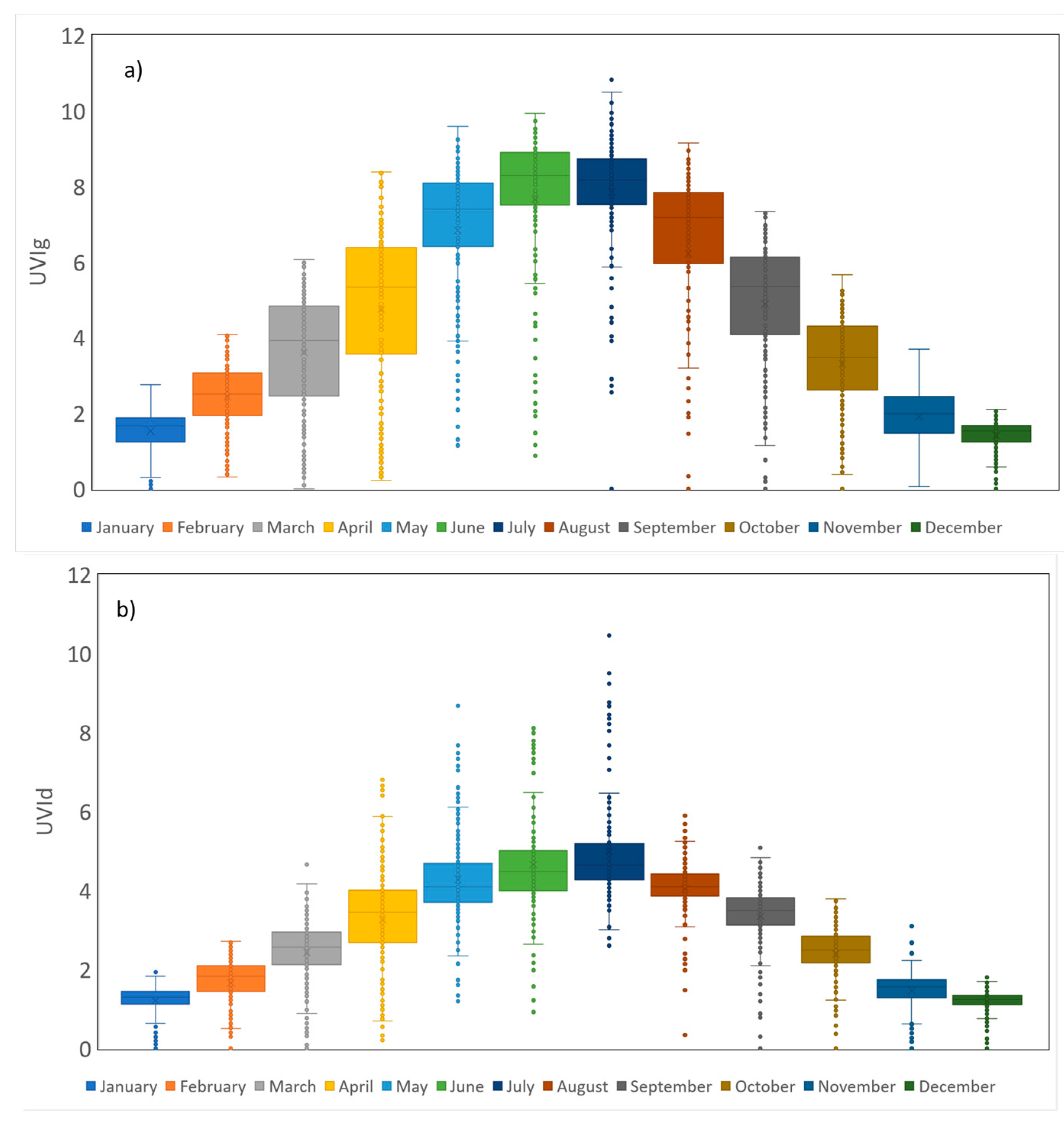
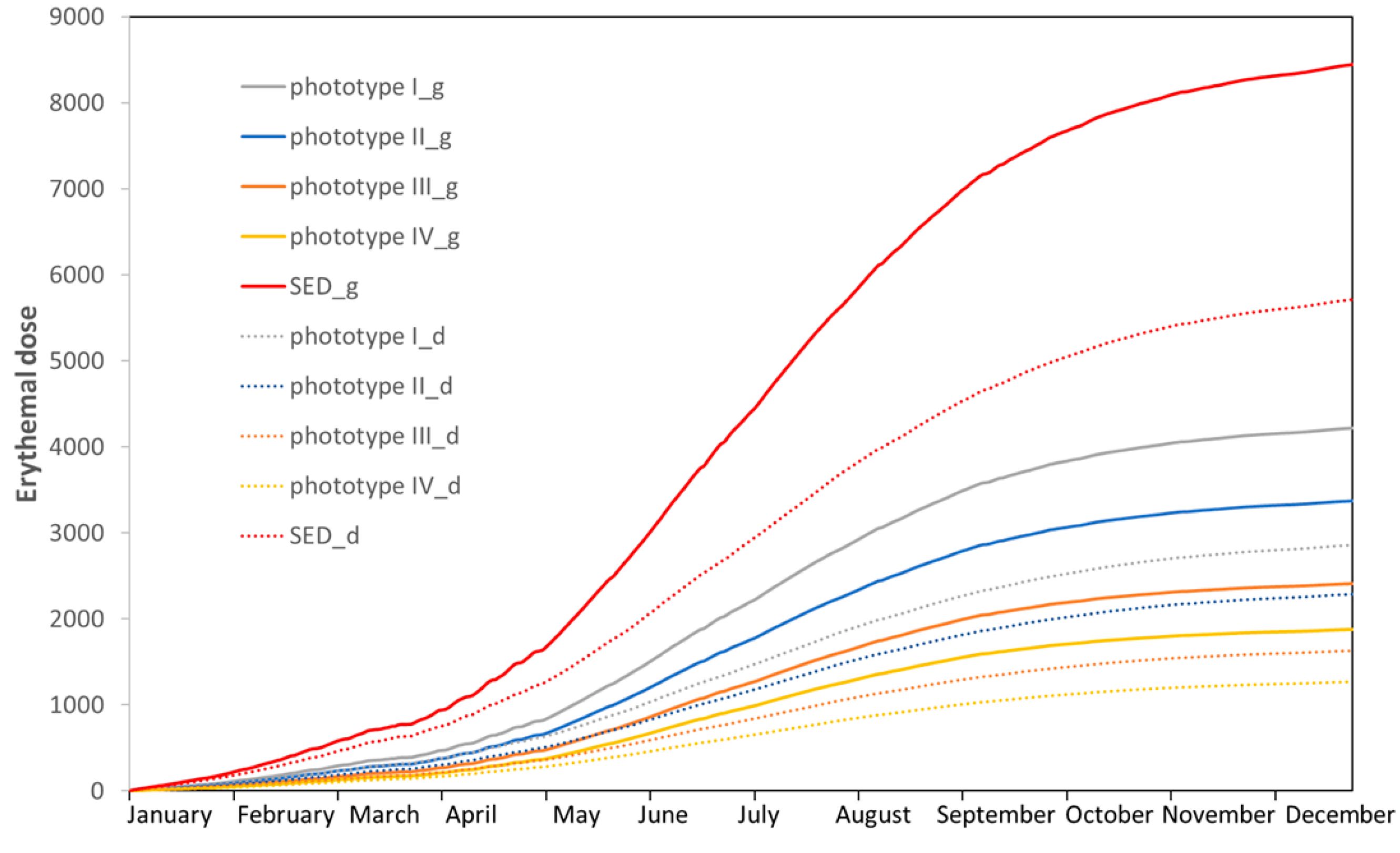
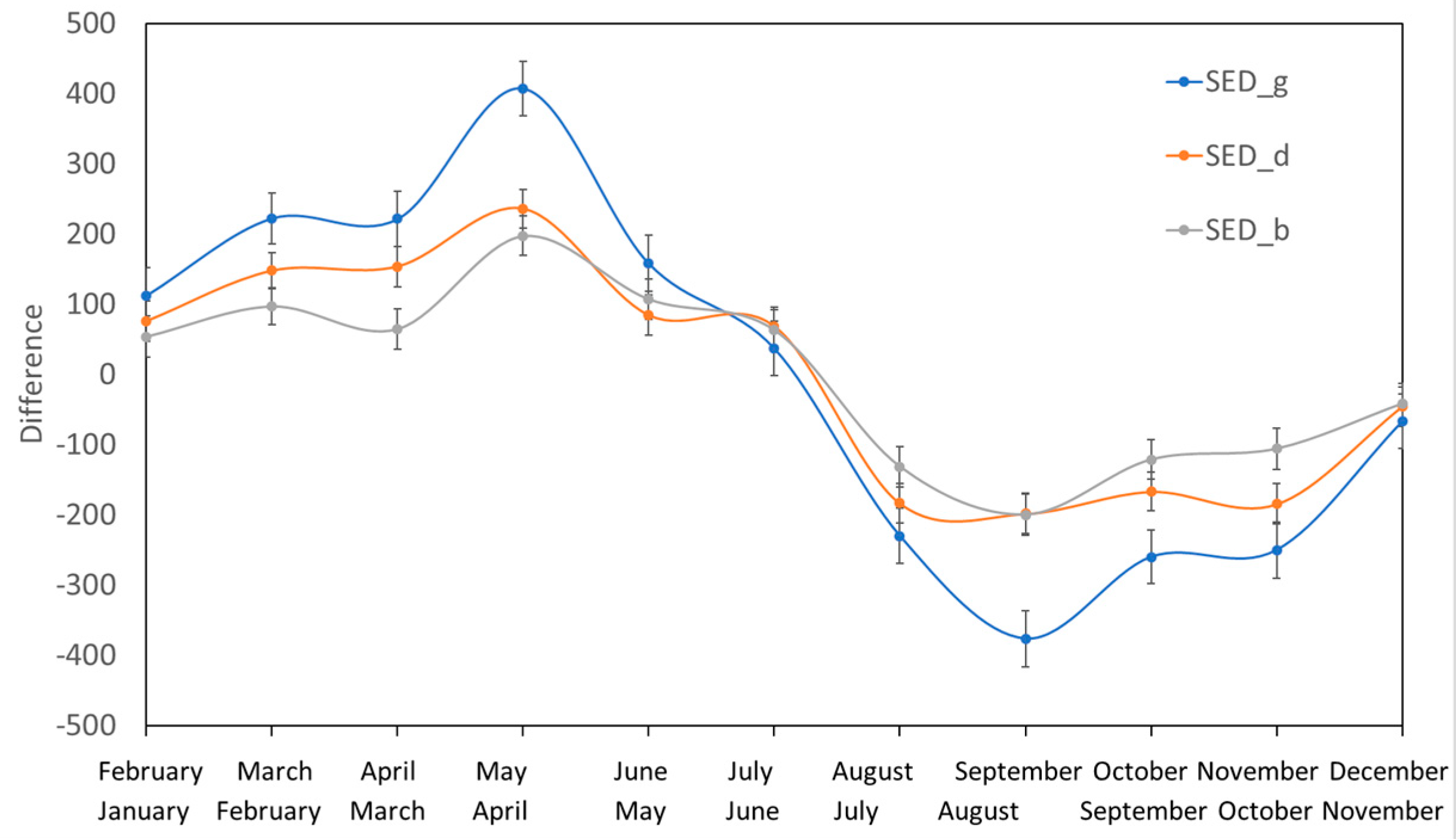

| UV Index Value | Global (%) | Diffuse (%) | Direct (%) |
|---|---|---|---|
| {−1, 0, 1} | 88.0 | 95.4 | 90.3 |
Disclaimer/Publisher’s Note: The statements, opinions and data contained in all publications are solely those of the individual author(s) and contributor(s) and not of MDPI and/or the editor(s). MDPI and/or the editor(s) disclaim responsibility for any injury to people or property resulting from any ideas, methods, instructions or products referred to in the content. |
© 2023 by the authors. Licensee MDPI, Basel, Switzerland. This article is an open access article distributed under the terms and conditions of the Creative Commons Attribution (CC BY) license (https://creativecommons.org/licenses/by/4.0/).
Share and Cite
Marín, M.J.; Estellés, V.; Gómez-Amo, J.L.; Utrillas, M.P. Diffuse and Direct UV Index Experimental Values. Atmosphere 2023, 14, 1221. https://doi.org/10.3390/atmos14081221
Marín MJ, Estellés V, Gómez-Amo JL, Utrillas MP. Diffuse and Direct UV Index Experimental Values. Atmosphere. 2023; 14(8):1221. https://doi.org/10.3390/atmos14081221
Chicago/Turabian StyleMarín, María J., Víctor Estellés, José L. Gómez-Amo, and María P. Utrillas. 2023. "Diffuse and Direct UV Index Experimental Values" Atmosphere 14, no. 8: 1221. https://doi.org/10.3390/atmos14081221





